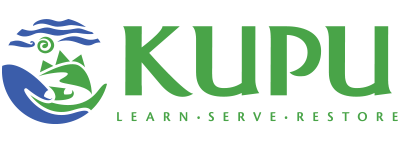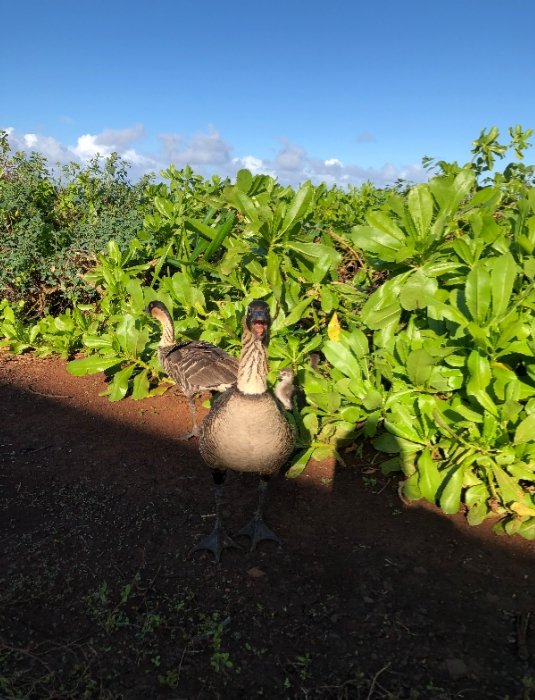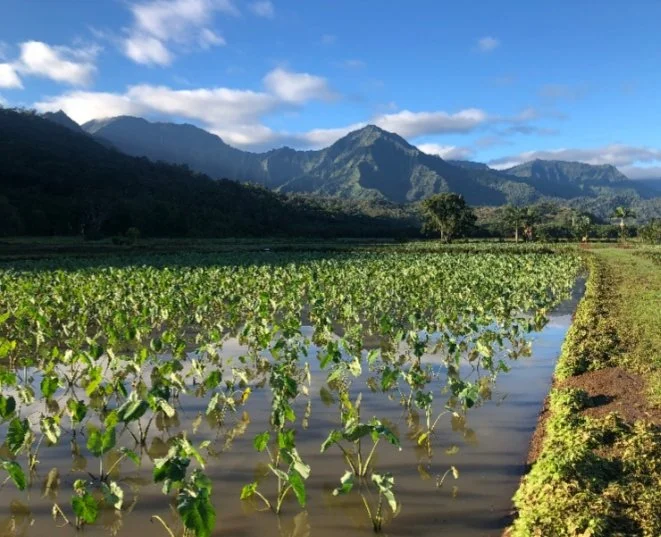Kupu Collaboration - Emily Brines
Posted 03/19/22 at 08:01h by Cassie Clark
Kupu Collaboration by Emily Brines, Kupu Conservation Leadership Development Program (CLDP) member based at Kawai’ele Waterbird Sanctuary.
One of my absolute favorite parts of my position with Kupu is how frequently I have the opportunity to serve with other teams to do conservation work, inside and out of my host site with DOFAW. Over the past month, I’ve had several experiences that have made me really thankful for this facet of collaboration in my position.
Nene parents and goslings seen at Kilauea Point NWR. A protective dad!
Morning on the Refuge- Late morning at the Hanalei National Wildlife Refuge.
With my supervisor out for the holidays, I was able to serve at the Hanalei Wildlife Refuge and Kīlauea Point for a few days. Working in the beautiful north shore area certainly isn’t the norm for my position, so I jumped at the opportunity. First thing in the mornings, I embarked on the daily botulism surveys. Botulism surveys are geared to get a handle on the botulism outbreak, by collecting dead birds to limit propagation and capturing sick birds for treatment. Fortunately, I didn’t see many dead things, and nothing sick. But the botulism surveys were enjoyable for another reason: the peace and beauty of the refuge in the mornings is unmatched. I attached a photo, but it can’t capture the calls of stilts and moor hens, the dew on the grass, and the smells that accompany the experience. In the afternoons I headed over to the lighthouse. Mostly I helped with out planting; perched on a blustery hill leading down to the ocean, I worked with one of the USFWS personnel to plant hala, naio, and a scrub-like crawling plant designed to hold earth. The idea is that the roots from these plants will help prevent soil eroding down the cliff. The view was not to be beat: brown boobies floated over the ocean and landed in trees nearby, and I could hear the calls of the albatross colony just up the hill.
Later in the month I found myself helping with a massive koa tree outplanting up in Kōkeʻe with the DOFAW Forestry department. There were a lot of volunteers from different organizations, and together we planted almost 1,500 seedlings! Teams worked to drill holes in the ground with augers, put in polymer to help the seedlings grow, plant the seedlings, and finally water them. There is something about planting native plants that feels really meaningful. Digging in the red earth, surrounded by people laughing and happy to be out in the field, with clear skies and an amazing view of Niʻihau and Lehua (islands off the west side of Kauai)… something is just right about that. Thankful for a beautiful first month in 2020, and looking forward to the next several months of service.
Baby koa in the foreground, Ni’ihau and Lehua in the background
Outplanting naio, endangered sedges, and ohai on islands at Kawai’ele in collaboration with NTBG interns.
Kupu
Kupu, which means “to sprout” or “to grow”in Hawaiian, has a two-fold mission: to preserve the land while empowering youth. The organization provides hands-on training in conservation, sustainability, and environmental education for young adults, with the goal of fostering our next generation of environmental and cultural stewards. Kupu’s work has been likened to the role of the Kupukupu Fern which is one of the first plants to cultivate the land after a lava flow. The fern not only serves as a foundational species for rebuilding a healthy, native ecosystem, but it also symbolizes a place where knowledge can grow.
Established in 2007 as a Honolulu-based 501(c)3 non-profit, Kupu affirms the Hawaiian notion of “ma ka hana ka ʻike” or “in working one learns.” This approach has led to the creation of hundreds of internships and service-learning opportunities which blend vocational training and green leadership development to support more than 100 partner sites across Hawaiʻi and the Pacific region. For more information please visit: www.kupuhawaii.org. Mahalo.




